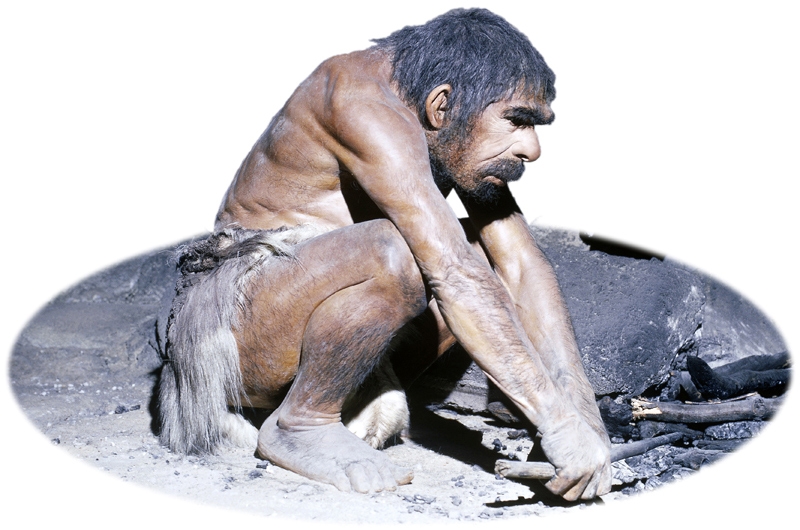The human species that today makes astounding advances in technology, and particularly in the medical field, did not exist four million years ago. In fact, hominids of that period were very different from the modern species in many ways. How did humans evolve to become today’s humans? How did Homo sapiens become so innovative? For one, they developed favorable qualities that were essential for adaptation and a thriving existence.

Homo sapiens derived from a form of early humans called Neanderthal. Unlike modern humans, characteristics of the Neanderthal included occipital buns and protruded brow ridges.1 One important facial feature of the Neanderthal was their large nose for “humidifying and warming cold, dry air” before it reached the lungs.2 Modern humans do not have this characteristic due to the fact that the Neanderthals lived in much harsher conditions. Thanks to the work of archaeologists and anthropologists, we know a great deal about the life and world of Neanderthals. The first fossils of these humans were found in France, and scholars have since called these humans Cro-Magnon. They created innovative tools from bones and antlers for hunting. This enabled them to survive and thrive in their environment. They even created artwork “in the form of decorated tools, beads, ivory carvings of humans and animals, clay figurines, musical instruments, and cave paintings.”3

Homo sapiens originated from East Africa. From there homo sapiens have migrated to all of earth’s main land masses. By taking advantage of land bridges, they have spread to Indonesia, New Guinea, Australia, and the Americas. Another contributing factor to the spreading of humans was the recent major Ice Age. The freezing of the oceans’ waters around the polar caps lowered the sea level, which exposed land bridges between land masses that were otherwise under water. For example, the connection between Calabria and Sicily had a sea level around -126 meters.4 They were able to adapt to the different environments due to their larger brain capacities, hence more intelligence. Having the knowledge that they had, they were able to create warm clothes and shelters to survive under various harsh conditions in the regions they occupied. Since they were nomadic people, there was no economic prosperity during the Paleolithic era. This was due to the fact that they never inhabited an area for a long duration of time. They were foragers; they scrapped up whatever they could find for survival, so there was no time period in which they could accumulate wealth. With that being said, that meant that there were no social classes. Instead, they lived an egalitarian lifestyle. While the men hunted, the women gathered. This method sustained their existence until the Neolithic Revolution, which domesticated both plants and animals.
The evolution of earlier hominids to Homo sapiens opened the door to a species capable of more advanced thinking about their surroundings and survival. The human race has since continued to thrive to the present. Without their innovative tools, body structures, and eventually domestication of plants and animals, Homo sapiens would not have been able to produce the advancements in technology and sciences that we have available today.
- Markus Bastir, Paul O’Higgins, and Antonio Rosas, “Facial Ontogeny in Neanderthals and Modern Humans,” Proceedings of the Royal Society B: Biological Sciences 274, no. 1614 (May 7, 2007): 1125–32. ↵
- Todd C. Rae, Thomas Koppe, and Chris B. Stringer, “The Neanderthal Face Is Not Cold Adapted,” Journal of Human Evolution 60, no. 2 (February 2011): 234–239. ↵
- “Evolution: Humans: Origins of Humankind.” Accessed September 10, 2016. http://www.pbs.org/wgbh/evolution/humans/humankind/o.html. ↵
- Fabrizio Antonioli, V. Lo Presti, M. G. Morticelli, M. A. Mannino, Kurt Lambeck, Luigi Ferranti, Catriona Bonfiglioli, et al., “The Land Bridge between Europe and Sicily over the Past 40 Kyrs: Timing of Emersion and Implications for the Migration of Homo Sapiens,” Rendiconti Online Societa Geologica Italiana, 2012. https://openresearch-repository.anu.edu.au/handle/1885/71477. ↵



99 comments
Engelbert Madrid
It’s incredible to me of how humans have moved along for thousands of years in this world. Human evolution is incredible to learn because it helps readers like me to have a further understanding of how we become what we are now. The adaptation of new skills, such as making tools and hunting, are abilities that we inherited by our ancestors and that kept on going even in the modern world. Another great example of what we still make and use in our modern lives is art. Paintings are still important artifacts in many forms in societies.
Tyanne Pearcy
This article really caught my attention because I am learning about human evolution in this course. I have always had a big question mark on how humans have evolved through out time. In the article it talks about how homo sapiens were the first early humans. Homo sapiens adapted to their environment and mirrored our human structure today. As time went on they evolved in their level of intelligence and communities. This article definitely cleared some gaps about how the evolution of humans could have occurred.
Diego Aguilera
I really enjoyed this story as it gave me details and facts about early humans and how we came to be who we are today. This was like seeing our roots in a way. I would love if the article would have included more of modern day humans but other than that very great detail and keep me interested from the start. MY favorite part was with the hot and cold air to the lungs, great detail.
Alexander Manibusan
It would be nice to know a bit more about the evolutionary history of modern day humans. For instance, I think this article could have mentioned briefly about Homo erectus or maybe even Australopithecus. Though I’m glad the article did touch on how early humans migrated and how land bridges appeared due to the ice age. I really wonder what it was like to go from Asia to the Americas and crossing that land bridge.
Daniela Duran
Articles like this one really open up our minds and curiosity. It is truly impressive to understand where we come from and how we got to where we are. I have always had that doubt in me, about how the human race got to populate the entire world, and this article finally allowed me to understand the logistics behind it. I was really impressed by the adaptation that the human develops, according to its environment…for instance, the long nose that was meant to warm up the air before it reached the lungs is amusing. This only makes me think about the great capabilities that the human race has, even if not consciously using them! we are probably evolving all the time just like we did back then! The intelligence of the human being clearly led to creation of all of those weapons, artefacts and clothing, and it will be interesting to keep on discovering what else we can create across time. I wonder, however, if we adapt to our environment, and we are increasingly allowing technology to do our work…will the human being eventually become adapted to this? will we become less capable of doing things? Will our body evolve to satisfy the lack of movement and activity needed?
Pamela Callahan
I find it fascinating to think that humans are able to adapt to their environments and that we have evolved so much over the years. Originally, over thousands of years, we were forced to adapt to our environments and we grew and changed accordingly in able to survive. Now we have grown so much that we are able to change the environment around us in order to fit our needs. I think that was a big step for human kind and was, in the end, one of the major factors that led to the eventual development of civilizations.
Christopher Hohman
Nice article. It is so cool to learn about the different species of hominids that walked the earth before us homo sapiens. To think that the homo- sapiens who lived in hunter gather societies are not so different from us who live in an advanced society is crazy. It is funny how the agriculture revolution bread all these other aspects of civilization. we needed people to look after surplus so wealth came into being. We closer together for longer periods of time, so we needed to treat new illnesses, we needed to learn to live and work together, so we created governments to manage our civilizations. Very cool
Isaac Saenz
I always enjoy learning about human history, whether it be recent, thousands of years ago, or even millions. The human being is such a phenomenal and mysterious creature, it is hard to believe how far we have evolved from being simple bacteria. This article does a great job at explaining our beginnings and how we got to where we are today. It is amazing how different but also how alike we are to our ancestors even so long ago.
Caroline Bush
Interesting article! I really enjoyed the pictures and the title of this article and found the amount of details to be very captivating. I really enjoyed the timeline you used in the article and how you used it to trace the evolution of man to our modern day humans. I really enjoyed the details about how they had big noses to warm the cold air before it reached their lungs. Overall this was a very interesting article over a very interesting topic. I really enjoyed reading this article and found it to be a great explanation about modern man and the discovery of their early life.
Timothy ODekirk
It is so interesting to think that what we do today as a people and as a society has everything to do with our ancestors. That statement just astonishes me. This article was extremely intriguing to me, especially in the conclusion of the article, when it says that we depend on our ancestors. Everything we do comes from our ancestors and of the simplistic lifestyle that they had. Our critical thinking skills, our ability to solve problems in a given situation has everything to do with the simplistic lifestyle that our ancestors lived. This was an absolute fantastic article and really blew my mind and made me think about the evolution of human kind.